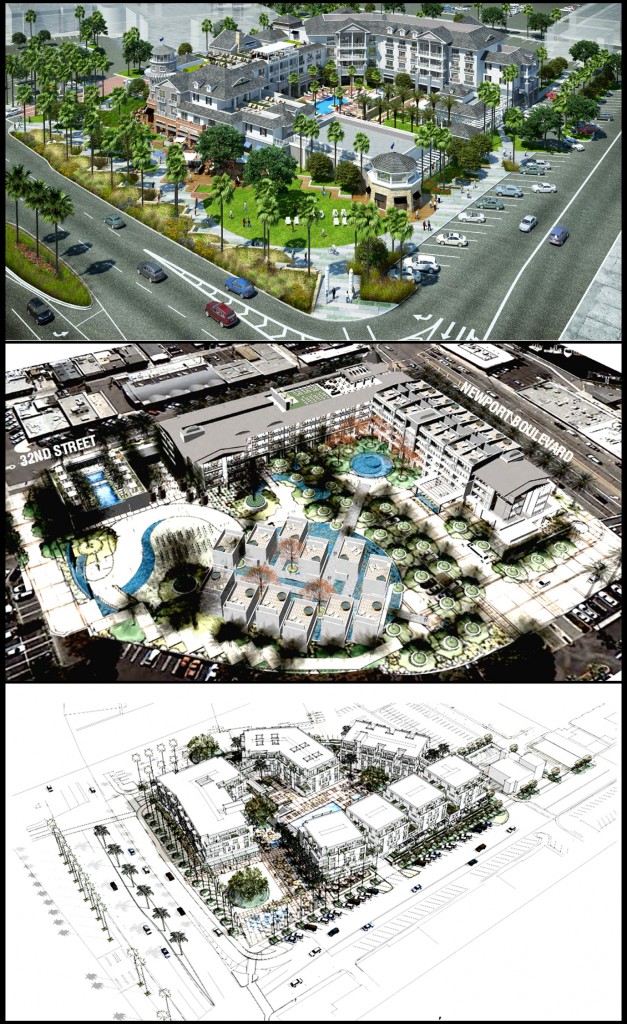With a nearly packed house in the chambers at the new city hall, Newport Beach City Council heard proposals Tuesday regarding what to do with the old city hall site.
During the council’s afternoon study session, three proposals were on the table for the property at 3300 Newport Blvd., from RD Olson Development, Sonnenblick Development, The Shopoff Group.
Community response at the meeting was largely in favor of a hotel, with a handful of residents speaking during public comment, including Lido Isle Community Association spokesman, Hugh Helm.

“We all recognize the great need to revitalize Lido Village,” Helm said, “and the city hall site re-use is the key first step.”
The first proposal was from Bob Olson, of RD Olson Development, who presented a 130-room boutique hotel called the Lido House Hotel.
The facility would include a restaurant, spa and fitness center, bay to beach park, ballroom and meeting room, rooftop lounge and viewing deck.
During the next 10 years, the hotel would bring approximately $400 million of direct and indirect spending from hotel guests and about $17 million in taxes to the city, according to Bruce Baltin, senior vice president for PKF Consulting.
The architecture is “reflective of our community, but at the same time raises the bar on the identity” of the area, Olson said, calling it “Newport Nautical.”
It will be set back from the street with trees and greenery in front, including preserving the two existing special landmark ficus trees.
The most important piece to the project is that it blends well with the community, Olson said, and is an “extension of the local culture” and a “fun place to be.”
Robert Sonnenblick, chairman of Sonnenblick Development LLC, proposed a hotel consisting of 20 town homes, 12 villas and guest rooms.
The Sonnenblick property would include public courtyards, plazas and promenades, two restaurants, rooftop bar, lounge and event area, health spa, several water features, outdoor event areas, meeting space, and 210 below grade parking spaces.
The two special ficus trees and public parking on 32nd Street will be removed.
The 10-year economic impact would be about $682 of direct and indirect spending by hotel guests and approximately $1.6 million annually in tax revenue, according to Sonnenblick partner, David Rose
The architecture will be a fusion of “coastal residential,” “seashore cottage” and “resort luxury,” according to the Sonnenblick proposal.
The only mixed-use proposal came from William Shopoff, president and chief executive officer of The Shopoff Group.
The Shopoff project would consist of 99 luxury apartment homes and 15,000 square feet of upscale retail space.
The commercial area would include restaurants, community meeting room, pedestrian walkways, water features, a parking garage, and a town square and public plaza. The ficus trees will be preserved.
The average rental rates are expected to run between $5,000 to $6,000 per month, Shopoff said.
“We believe the overall economic value to the city is as good as, or superior to, the hotel alternative with significantly lower risk,” he added.
It would be a public and private partnership, said Peter Wolff, vice president of development for the Wolff Company.
This project is a perfect fit, he said.
“There aren’t many cohesive projects, this scale, in this area, which have the opportunity to start with a clean slate,” Wolff said, so it’s important to treat it properly.
Shopoff said he hoped the site will be the “most exclusive rental building in Orange County.”
Councilwoman Nancy Gardner brought up possible California Coastal Commission requirements.
After monitoring recent CCC approvals of high-end hotels, staff found they have been charging a mitigation fee, most recently $30,000 per unit, because they aren’t low cost visitor services.
Staff also noted that the addition of retail space in the mixed-use project may be looked at by the Coastal Commission as a benefit to the public and that they have not seen the same type of mitigation fees as seen with the hotel properties.
Following the presentations, residents voiced their opinions during public comment.
Helm references a resident poll that strongly supported a hotel site, which would act as a “jump start” to the revitalization, he said.
“Either one of (the proposed hotels) would be a fantastic addition and improvement to our community and would generate a lot of further ‘trickle down’ support and economic development,” Lido resident, Roberta Fessler
Fessler compared the project to when the city of Los Angeles built the Staples Center and that area was revived and is now the thriving center of the downtown area.
“It all started with a city council that was willing and visionary enough to appreciate the importance of putting a vibrant activity and entity in that property,” she said. “That’s what you have the opportunity to do here, if you agree and select one of the hotel proposals to generate that very kind of revitalization in our area that is very, very much in need of it.”




